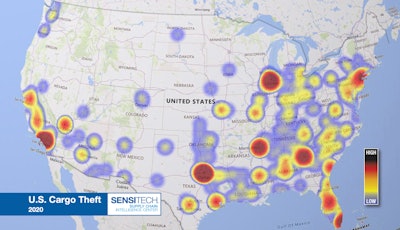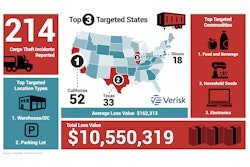
If the COVID-19 coronavirus pandemic and the economic hardships -- business failures, rampant unemployment, extended closings -- it wrought weren't enough, it appears 2020 was also plagued by record amounts of cargo theft.
According to cargo theft recording firm Sensitech’s annual report, cargo theft volumes and values in the U.S. increased in 2020 over the previous year and also hit a five-year high.
Sensitech recorded 870 cargo thefts throughout the U.S. in 2020 – 222 in the first quarter, 230 in the second quarter, 185 in the third quarter and 233 in the fourth quarter. The average value of 2020 thefts was $166,854.
These numbers represent a 23% increase in volume and a 41% increase in average value when compared to 2019. The numbers also represent the highest recorded volume and average value in the last five years, Sensitech adds.
2020 represents a second consecutive year with an upward trend in reported cargo theft volume, which prior to 2019 had been in decline since 2011.
Notable cargo theft trends in 2020 include pandemic-influenced product targeting and a record-breaking year for pilferage. Primarily, the rise in pilferage has fueled the increase in thefts, Sensitech says, as large-scale pilferage events accounted for 43% of total thefts. Pilferage is the theft of small portions of a load rather than stealing a full load.
Additionally, product targeting in the pandemic was specific to merchandise that was already in shortage, ensuring quick liquidation and easy resale for the thieves. These products included toilet paper, disinfectants, personal protective equipment, ventilators and more. This is in line with Sensitech’s data showing miscellaneous products being the most stolen for the year for the first time, accounting for 23% of all thefts.
Sensitech found that 48% of all recorded thefts in 2020 occurred in just three states – California (20%), Texas (18%), Florida (10%).
Cargo theft by month in 2020 was more volatile than typical years in which the fourth quarter normally ranks highest. Last year, April was the busiest month for cargo theft, logging 11% of the annual total. December, with 10% of the year’s total, was the next busiest month.
The firm notes that its data is an indirect representation of the overall cargo theft footprint and not a direct reflection. It uses data from transportation security councils, insurance companies and law enforcement organizations, which may not represent 100% of all thefts but does provide a cross-section of thefts to identify trends, the firm notes.










